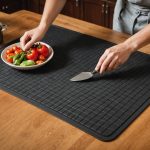Understanding Midnight Munchies and Their Impact
Midnight munchies, a common occurrence for many, are driven by a mix of psychological and physiological factors. Often, stress and emotional triggers prompt late-night eating, as individuals seek comfort in food. The body’s internal clock, or circadian rhythm, can also play a role, making some people more prone to cravings at night.
The impact of snacking late at night goes beyond just an extra helping of dessert. It can significantly affect overall health and wellness. Consuming high-calorie foods before bedtime can lead to weight gain and digestive issues, while also disrupting sleep patterns. This disruption occurs because the body’s metabolic processes slow down during sleep, making it harder to digest food efficiently.
Also to read : Effortless Meal Planning: The Definitive Guide to a Streamlined Kitchen for Diet Success
Addressing late-night eating habits is crucial for maintaining a healthy lifestyle. Recognising the triggers behind midnight munchies is the first step toward making informed choices. Developing strategies to counteract these cravings can lead to better sleep and improved health outcomes. One effective approach is creating a structured eating schedule and sticking to it, ensuring balanced meals throughout the day, which can reduce the urge to snack late at night. Understanding these aspects of midnight munchies can pave the way for healthier living and improved well-being.
Innovative Kitchen Design Hacks for Snack Control
Designing your kitchen with snack control in mind can significantly help manage those midnight munchies. By rethinking your kitchen’s layout and storage, you create an environment less conducive to late-night snacking.
Topic to read : Revamp Your Kitchen Layout: Smart Space Management to Curb Overeating
Layout Adjustments
To begin with, consider the placement of appliances and furniture. Position these elements strategically to make accessing snacks less convenient. Separate your designated eating zones from storage zones, creating a natural flow that deters unnecessary snacking. Arrange your kitchen so that movement naturally draws you away from snack-storage areas, subtly encouraging healthier habits.
Storage Solutions
Hidden storage can play a crucial role here. Conceal snacks to reduce their visibility, which in turn, minimizes temptation. Segmenting pantry and cabinets to prioritize healthier options ensures that when you do reach for a snack, you choose wisely. Using clear containers with labels adds transparency, keeping you aware of your choices.
Lighting Design
Lighting also influences behavior. Bright task lighting can deter late-night eating by making the kitchen less inviting at unplanned times. Consider dimming options to create an atmosphere that subtly discourages spending excessive time in the kitchen after hours, aligning your environment with healthier eating patterns.
Organization Tips to Promote Healthy Eating
Effective kitchen organization can be a major ally in crafting healthier eating habits. By aligning storage solutions with your wellness goals, you can naturally steer clear of midnight munchies and embrace a more balanced lifestyle. Central to this strategy is a thoughtful approach to food positioning and accessibility.
Start by considering a dedicated meal prep system to minimize cravings. Preparing meals and snacks in advance not only saves time but also ensures that healthy options are always within reach. This can deter impulsive, late-night snacking by creating a well-structured eating routine. An organized system gives you the power to make healthier choices effortlessly.
Incorporating a no-snack zone in specific areas of the kitchen can further reinforce disciplined eating habits. Designate cabinets and shelves for healthier options, making them the most easily accessible choices. This segmentation maintains clarity in your dietary goals and reduces temptation by keeping sugary or high-calorie snacks out of immediate sight.
Remember, a kitchen organized with health in mind can profoundly reduce the impact of snacking and redefine your late-night eating habits. Embracing these strategies transforms your cooking space into a place of nourishment and mindfulness.
Engaging Visuals and Expert Recommendations
Incorporating engaging visuals alongside expert advice can significantly enhance your understanding and implementation of effective kitchen design strategies for snack control. By offering before-and-after transformations, you can see firsthand how these strategies work in real-life settings.
Before-and-After Transformations
Real-life transformations provide a compelling insight into the power of design changes. They showcase how simple adjustments can lead to a more organised and efficient kitchen. These visual representations are not just inspirational but also offer practical templates that you can replicate in your own space. Users who have adopted these changes often report noticeable reductions in late-night snacking, demonstrating the effectiveness of these design strategies.
Infographics and Visual Guides
Infographics can distil complex concepts into easily digestible information. They serve as a visual guide to layout arrangements, storage solutions, and lighting hacks. By offering checklists, these tools facilitate the practical application of kitchen makeovers. This approach not only aids visual learners but also provides a handy reference as you work on your kitchen transformation.
By integrating expert recommendations with engaging visuals, you empower yourself with the knowledge and inspiration needed to create a kitchen that promotes healthier eating habits.
Actionable Steps for Implementation
Transforming your kitchen for effective snack control requires a clear roadmap. With practical tips and structured plans, you can seamlessly transition to healthier habits.
Step-by-Step Guide
-
Assessment: Begin by evaluating your current kitchen layout. Identify where snack temptations are prevalent and note any areas that encourage late-night access. This initial review provides a clear baseline for the changes needed.
-
Plan the Transformation: Use your assessment to shape your kitchen transformation strategy. Establish designated eating zones, away from snack storage, and plan for hidden storage solutions to reduce the visibility of junk food.
-
Implement Changes: Gradually apply the proposed alterations. Start with reorganizing storage areas, using clear containers for healthier snacks, and proceed to adjust lighting for a mood that discourages unnecessary nighttime visits.
Suggested Timelines
- Week 1-2: Begin with layout adjustments, focusing on appliance relocation and storage solutions.
- Week 3: Introduce lighting modifications, installing dimmers where necessary.
- Week 4 onwards: Finalize organization and ensure sustainable practices are in place to maintain your new snack-free environment.
To ensure long-term success, regularly evaluate your kitchen’s setup and remain flexible, adapting strategies as your needs and circumstances evolve.




